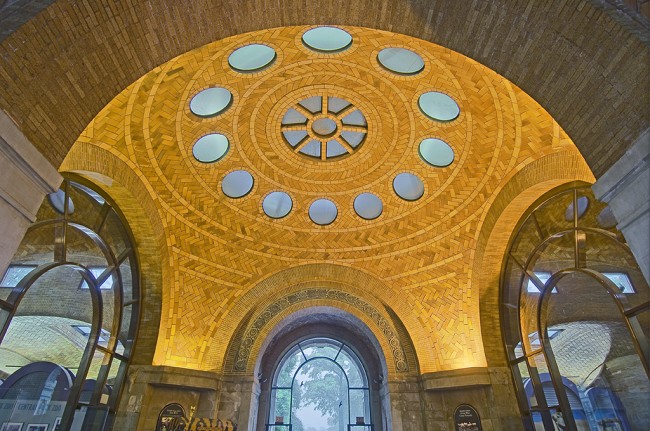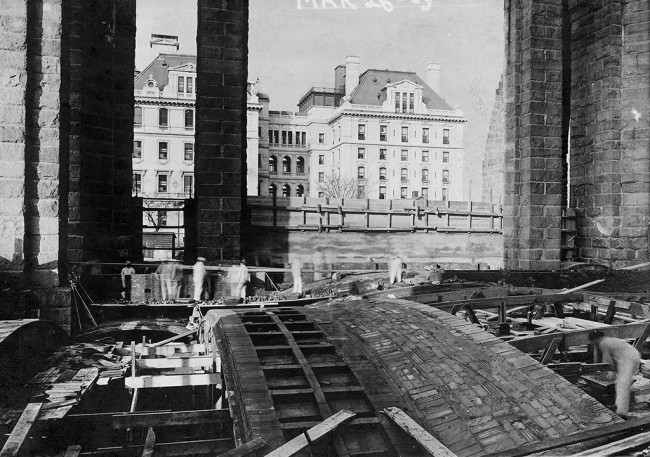
We are celebrating 15 years — and counting — of stories that are deeply researched and deeply felt, that build a historical record of what the city has been.
We are celebrating 15 years — and counting — of stories that are deeply researched and deeply felt, that build a historical record of what the city has been.

Ceiling of the Elephant House of the Bronx Zoo | © Michael Freeman, courtesy of the Museum of the City of New York
The exhibition Palaces for the People: Guastavino and the Art of Structural Tile, currently on view at the Museum of the City of New York (MCNY) through September 7th, features the extensive work of one the most innovative material practices of the late 19th and early 20th century: The Guastavino Company. The father-and-son team, who immigrated to the United States from Spain in 1881, deployed their knowledge of tile vaulting systems to collaborate with architects in the design and construction of ceramic structures for over 1,000 buildings throughout the United States, and over 300 in the New York City area.
The MCNY show was born out of the Guastavino Project, an ongoing research initiative at the Massachusetts Institute of Technology (MIT) where an interdisciplinary group under the direction of Professor John Ochsendorf is “dedicated to documenting and preserving the tile vaulted works of the Guastavino Company.” Professor Ochsendorf, an expert in masonry structures, teaches courses on structural design and structural form-finding in the Architecture and Civil Engineering Departments at MIT, and was awarded in 2008 the prestigious MacArthur Foundation fellowship in recognition for his research.[1]
Although this specific exhibition builds on the content of the initial one organized at MIT, it zeroes in on local projects, portraying New York at the turn of the 20th century as a fertile territory on which the Guastavinos were able to leave a profound imprint, helping shape the public image of the city during a period of transformation, growth, and intense construction of civic buildings and infrastructure. This capacity of the Guastavinos’ work to operate across multiple scales, to articulate a spatial narrative at the scale of the building while contributing to a new vocabulary of the public realm of the city, is emphasized by the fact that an exhibition about architecture and structures is on display at an institution dedicated to advancing and promoting the understanding of the city. A similar version of the exhibition now at MCNY has also been shown at the Boston Public Library, the site of the elder Guastavino’s first major project in the US, and the National Building Museum in Washington, D.C.

Construction of the tile vaults over the crypt at the Cathedral of Saint John the Divine in New York City | Photo courtesy of Avery Architectural and Fine Arts Library, Columbia University
The thin tile vaulting system that the Guastavino Company brought to the United States was based on the knowledge of Mediterranean vaults that Guastavino senior had learned about back in Spain. Using layers of thin ceramic tiles in combination with thick mortar, domes and vaults could be created, increasing material efficiency in less time and with more ease of construction. There was however one important innovation introduced by Guastavino to the system: Portland cement replaced the lime mortar used in traditional vaulting, creating an assembly of superior strength and improved water resistance.[2] These qualities of the construction system, in addition to its fireproofing properties, offered an attractive alternative to the prominent Beaux Arts architects of the city who were looking to create grandiose and majestic spaces to reflect the optimism and prosperity of the time. Eventually, after many decades of building hundreds of vaults and domes and several patented inventions, the Guastavino Company closed its doors in 1962 as it became impossible to compete with the development of a new technology that offered a more affordable alternative to the construction industry: thin-shell concrete roofs.[3]
Visitors to the exhibition can familiarize themselves with the Guastavinos’ work through a series of photographs, original construction drawings showing the importance of graphic statics in the generation of their structures, and miscellaneous objects, such as original samples of the vibrant color tiles manufactured by the company at their factory in Woburn, Massachusetts. Most of the material belongs to the Guastavino Fireproof Construction Company/George Collins collection at the Avery Architectural Fine Arts Library at Columbia University.
The exhibition highlights New York projects under three different categories or typologies: “An Enhanced Public Realm,” covering vaults and domes for civic buildings; “Cathedrals of Commerce,” demonstrating the application of thin tile vaulting and domes for commercial spaces like banks and restaurants; and “Soaring Structures,” referring to churches, synagogues, and other religious spaces. These projects include the Great Hall at Ellis Island, the City Hall Subway Station (closed to the public except for members of the MTA Transit Museum), the Oyster Bar at Grand Central Terminal, and the Cathedral of St. John the Divine. The Museum published A Guide to Guastavino in New York City to accompany the exhibition, a catalogue that contains a field guide to all the Guastavino Company work located in the five boroughs.
Another distinctive part of the exhibition is an interactive film, commissioned by the Museum specially for this occasion, that projects walkthroughs of several of the Guastavino projects located in the New York City onto a large screen. Viewers can use an iPad to control the animation and virtually navigate through spaces of eleven buildings that include the Zoo Center at the Bronx Zoo, the Municipal Building, and the Queensboro Bridge and Bridgemarket.
Vaulted Views was created by editor/producer Andrew Siwoff and Studio Indefinit, an interactive and experience design firm based in New York City. The team was hired by the Museum to create a two-fold design challenge: to allow visitors to view the Guastavino Company’s architectural masterpieces on a grand scale and to focus on the decorative detail of the tile work itself — curved surfaces that proved to be beautiful, sturdy, fireproof, and adaptable.
A half-size replica of a Guastavino vault built in 1889 is one of the most intriguing features of the whole show. The armature, supported by four steel pillars, allows the public to examine in detail the intricacies of the construction process behind the Guastavino structures, revealing the complex and beautiful assembly of tiles and mortar, which seems to resemble textile weaving or basketry more than ceramic construction. The mockup was built using methods described by the Guastavinos in their writings and drawings by a team of masons from the International Masonry Institute and The Bricklayers and Allied Craft Workers of Local Union #1 in New York, with assistance provided by a group of MIT students.
The legacy of the Guastavinos’ ceramic vault construction is a significant antecedent in a trajectory of 20th century work that explored the synthetic qualities and resistant virtues of form. Such is the case with the reinforced ceramic structures designed and built by the Uruguayan engineer Eladio Dieste, which I had the opportunity to visit with the support of The Architectural League’s Deborah J. Norden Fund travel grant. Dieste’s material investigations, similar to the ones carried out by the Gustavino Company, were concerned with the creation of slender and efficient long span structures for public or utilitarian buildings that could reveal the poetic and aesthetic qualities of structural form. He developed an innovative repertoire of masonry structural types that included ruled surfaces, self-supporting vaults, double-curved (gaussian) vaults and folded plates, systems that are still considered engineering breakthroughs to this day. And although it is evident that both approaches differed with regards to the exact techniques, processes, and outcomes, unarguably the Guastavinos’ work “provided the foundation of theory and experience upon which Dieste’s generation of designers would develop their unprecedented structures.”[4] Similarly, contemporary architecture can reflect upon these precedents when considering the potential use of material and structure as catalysts for spatial invention.
The author wishes to thank the staff at The Museum of the City of New York for their generosity of time and information, in particular Sara Spink, Curatorial Associate, and Justyna Zajac, Communications Manager.
NOTES:
[1] More information about Professor Ochsendorf’s research at MIT can be found at web.mit.edu/masonry and web.mit.edu/structuraldesign.
[2] John Ochsendorf, Guastavino Vaulting: The Art of Structural Tile (New York: Princeton Architectural Press, 2010), 29.
[3] Ibid, 186–188.
[4] Edward Allen, Guastavino, Dieste, and the two revolutions in masonry building. In: S. Anderson, ed., Eladio Dieste: Innovation in Structural Art (New York: Princeton Architectural Press), 66-75.
The views expressed here are those of the authors only and do not reflect the position of The Architectural League of New York.